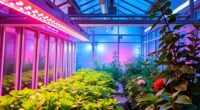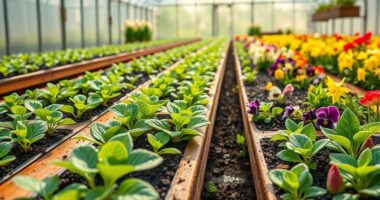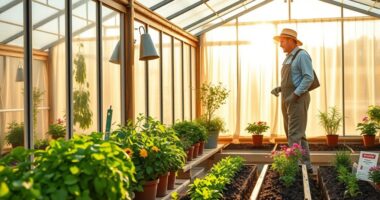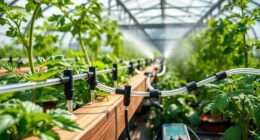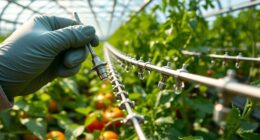To set up your greenhouse for spring, start with a thorough deep cleaning and surface disinfection to eliminate pests and pathogens. Organize your space efficiently, utilizing shelves and designated zones for different activities. Prepare your soil by testing pH levels and adding necessary amendments for optimal fertility. Don’t forget to implement environmental control systems to maintain ideal conditions. With these steps in place, you’re on the right track for a flourishing growing season, and there’s more to explore.
Key Takeaways
- Deep clean the greenhouse by removing plants and debris, then disinfect surfaces with appropriate cleaners for a pest-free environment.
- Organize the greenhouse into zones for specific activities, using shelving and hanging planters to maximize space.
- Prepare soil by testing pH levels, adding compost, and ensuring it is well-drained and nutrient-rich for optimal plant growth.
- Implement environmental control systems to maintain ideal temperature, humidity, and CO2 levels for healthy plant development.
- Time planting based on local frost dates, and harden off seedlings to prepare them for outdoor conditions before transplanting.
Deep Cleaning the Greenhouse
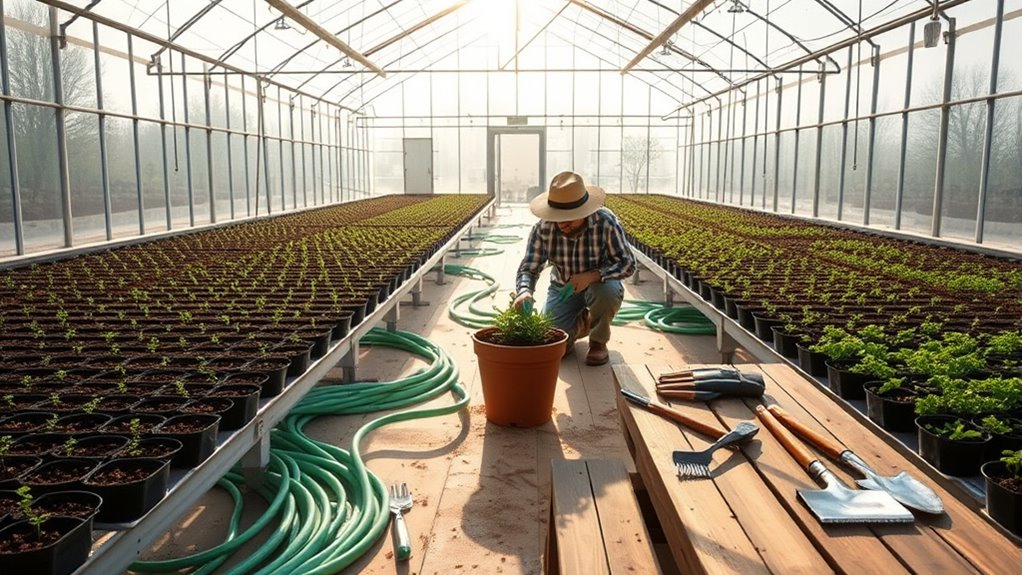
Before diving into the growing season, you’ll want to give your greenhouse a thorough deep clean to ensure a healthy environment for your plants.
Start by removing all plants, pots, and equipment, allowing you to inspect for overwintering pests like slugs and aphids.
Remove all plants, pots, and equipment to check for any overwintering pests like slugs and aphids.
Sweep the greenhouse from top to bottom, clearing away dust and debris.
Identify any algae or moss that needs scrubbing, and gather your cleaning tools, including brushes and buckets.
Use eco-friendly cleaners for a gentle yet effective clean, employing a toothbrush for small areas and a scrub brush for larger surfaces.
Rinse everything thoroughly with a hose, ensuring your greenhouse is sparkling and ready for new growth.
Surface Disinfection Techniques

After giving your greenhouse a thorough deep clean, it’s time to focus on surface disinfection to eliminate any remaining pathogens.
Start with choosing your disinfectants—alcohol, bleach, hydrogen dioxide, and quaternary ammonium chloride salt are effective options. Remember to clean surfaces first to remove organic matter that can neutralize these agents.
Apply disinfectants using sprayers for walls and floors, or soak tools for thorough sanitization. Ensure you maintain the appropriate contact time of 15 to 30 minutes for maximum effectiveness.
Always wear protective gear like gloves and goggles, and consider footbaths to prevent cross-contamination.
Keep in mind that porous materials like wood are harder to disinfect, so take extra care with those surfaces.
Organizing Greenhouse Space Efficiently
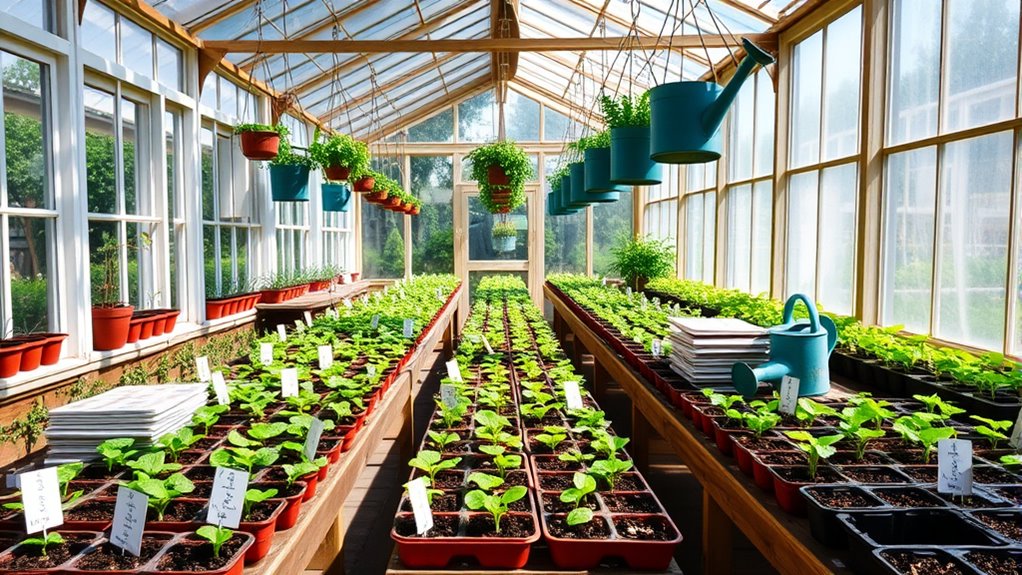
To maximize your greenhouse’s potential, organizing the space efficiently is essential for promoting healthy plant growth and simplifying maintenance tasks.
Start by zoning your greenhouse for activities like potting, storage, and plant growth. Use multi-level shelving and tiered plant stands to make the most of vertical space while ensuring good air circulation.
Zoning your greenhouse for specific activities and utilizing vertical space with shelving can enhance air circulation and plant growth.
Narrow pathways can increase planting space but must remain accessible for maintenance. Incorporate hanging planters and wall-mounted shelves to free up floor space.
Designate areas for tools and supplies, and keep everything labeled for easy identification. Regularly tidy your space, ensuring all plants are within reach and that light distribution is managed. Additionally, implementing efficient greenhouse design principles can further optimize your setup for maximum productivity.
This organized approach will enhance your greenhouse’s productivity and functionality.
Preparing Soil for Planting
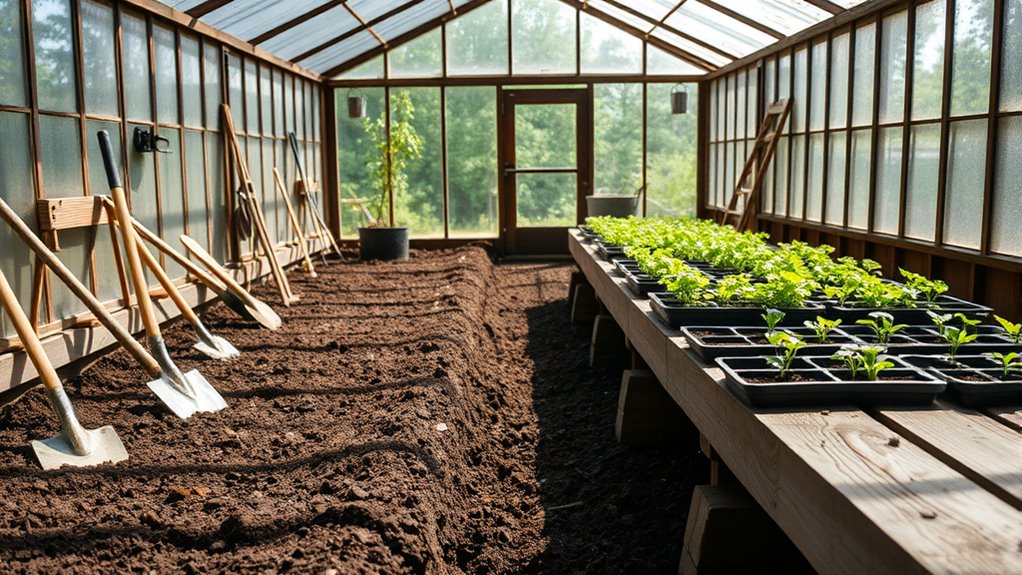
Preparing soil for planting is crucial for ensuring your plants thrive, as the right soil conditions can significantly impact growth and yield.
Start by conducting soil tests to check pH levels and identify nutrient deficiencies. Once you know your soil’s needs, add amendments like compost, peat moss, or worm castings to enhance fertility and structure.
If you’re reusing old soil, pasteurize it to eliminate pests and pathogens. Ensure your soil retains moisture by incorporating materials like perlite or coconut coir.
Regularly monitor and adjust pH levels with lime or sulfur as needed. By preparing your soil properly, you’ll create a solid foundation for healthy, productive plants throughout the growing season.
Essential Environmental Control Systems
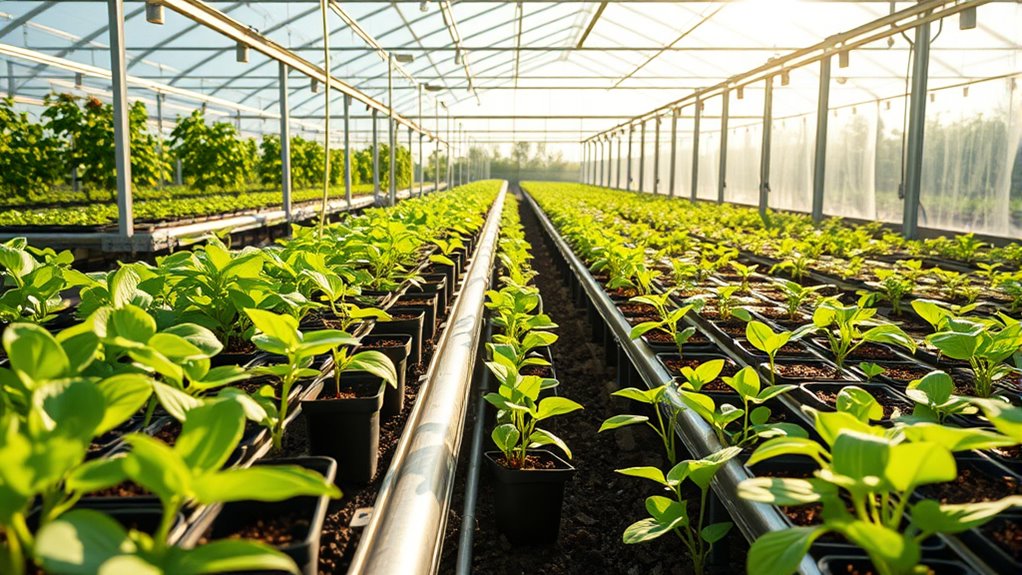
Creating the right environment for your plants is essential for their growth and productivity. Start by ensuring your greenhouse maintains optimal temperatures between 55°F and 85°F.
Creating an optimal greenhouse environment with temperatures between 55°F and 85°F is vital for plant growth and productivity.
Manage humidity levels around 80-90% using humidifiers or dehumidifiers as needed. Enhance growth with CO2 enrichment, targeting levels around 1000 ppm.
Energy-efficient LED lighting systems allow precise control over light spectrum. Proper ventilation is crucial; use automated vent openers and exhaust fans to maintain airflow.
Implement sensors for monitoring temperature, humidity, and CO2 levels, and consider remote monitoring for convenience. Setting up alert systems can help you respond quickly to any anomalies.
With these essential environmental control systems in place, you’ll create a thriving greenhouse environment for your plants.
Selecting the Right Plants for Spring
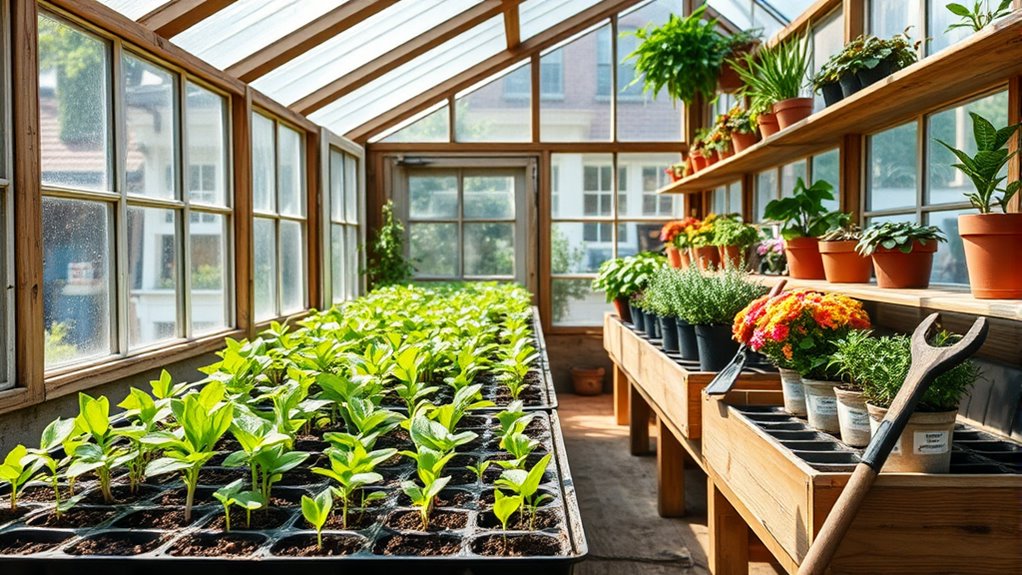
What plants should you consider for your spring greenhouse? Start with frost-tolerant options like pansies, snapdragons, and violas to add vibrant color early in the season.
For edibles, focus on fast-growing crops such as lettuce, spinach, and radishes; these can be harvested quickly, allowing you to plant more.
Don’t forget about cool-weather crops like broccoli and cauliflower, which thrive in lower temperatures.
Compact herbs like cilantro and parsley are perfect for maximizing space while providing fresh flavors.
Group plants with similar soil needs together for easier nutrient management.
Sowing Seeds and Propagation Methods
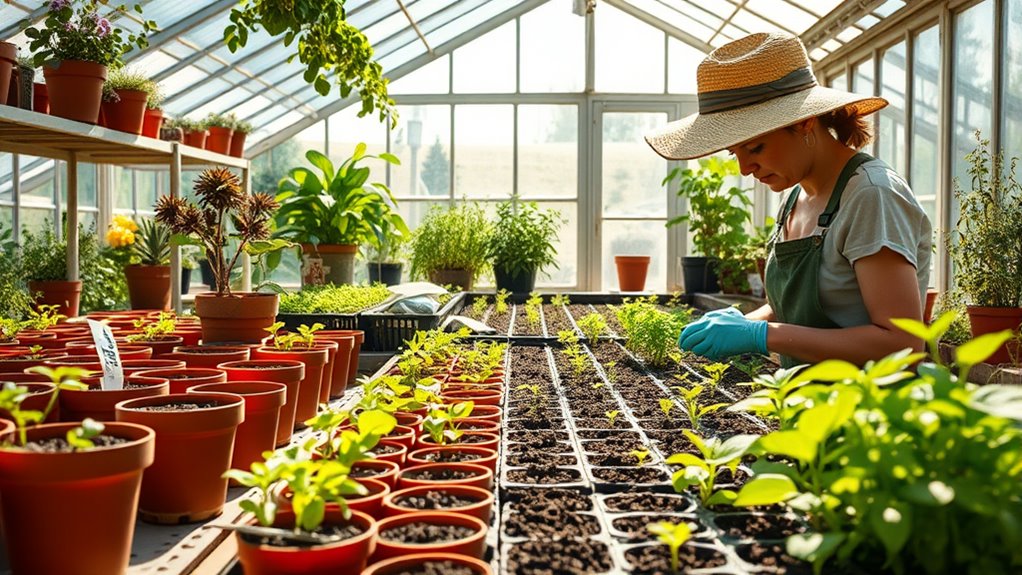
After selecting the right plants for your spring greenhouse, the next step is sowing seeds and exploring propagation methods to ensure healthy growth.
Start with high-quality seeds and a sterile, well-draining seed starting mix. Plant seeds 2-3 times their diameter deep, and maintain consistent moisture without overwatering.
Utilize heat mats to keep soil temperatures between 65°F and 70°F for optimal germination. Cover trays with plastic wrap or humidity domes to boost humidity, and ensure good air circulation to prevent diseases.
Label each pot with the plant variety and planting date. By following these steps, you’ll create the perfect environment for your seeds to thrive and set the stage for a bountiful growing season ahead.
Effective Pest Management Strategies
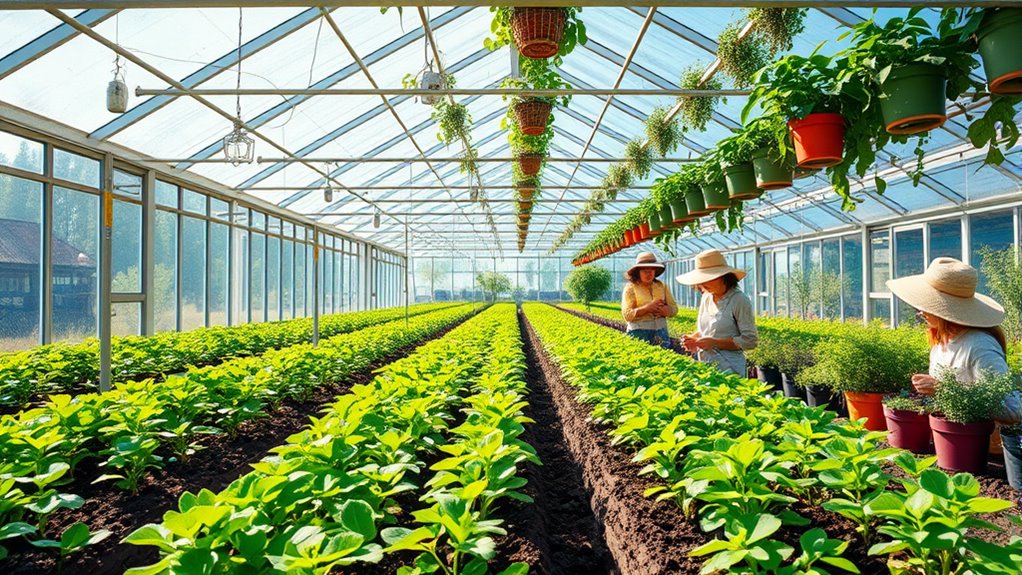
To ensure your spring greenhouse thrives, implementing effective pest management strategies is crucial.
Start with Integrated Pest Management (IPM), introducing beneficial insects like parasitic wasps to control aphids. Adjust your growing conditions—maintain optimal temperature and humidity—to prevent pest proliferation.
Regularly inspect your plants for early signs of pests; catching issues early makes a big difference. Use insect screens on air intakes to block unwanted visitors and keep thorough records of your pest management efforts for future reference.
Don’t forget spring cleaning: remove old plant material and disinfect tools to minimize potential hazards.
With these strategies in place, you’ll create a healthy environment for your plants and keep pests at bay.
Maintaining Optimal Watering Practices
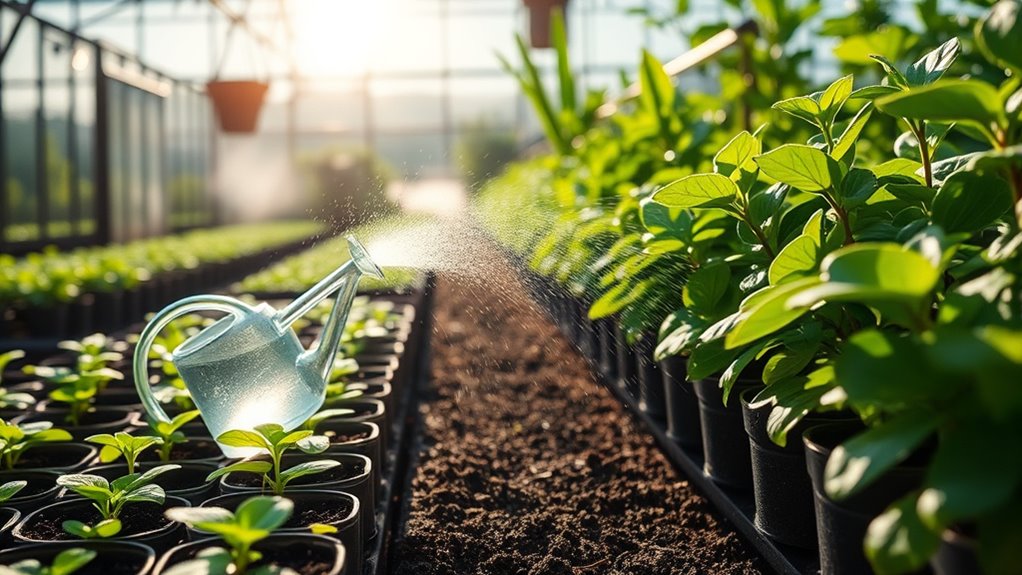
Maintaining optimal watering practices is essential for the success of your spring greenhouse, as it directly impacts plant health and growth. Pre-soaking your potting soil prevents it from becoming hydrophobic, ensuring seeds stay put.
Utilize misting systems to keep seeds moist without displacing soil. Aim for a balance—keep the soil moist but not soaked to avoid leaching nutrients or root rot. Water in the morning to allow absorption before the heat hits.
Regularly check moisture levels to avoid overwatering or underwatering. Consider drip irrigation to deliver water efficiently to roots while minimizing waste. Additionally, always be aware of water sources that can be utilized for your greenhouse needs.
Lastly, be mindful of weather changes and adjust your watering schedule accordingly to promote strong, healthy plants.
Timing Your Outdoor Planting
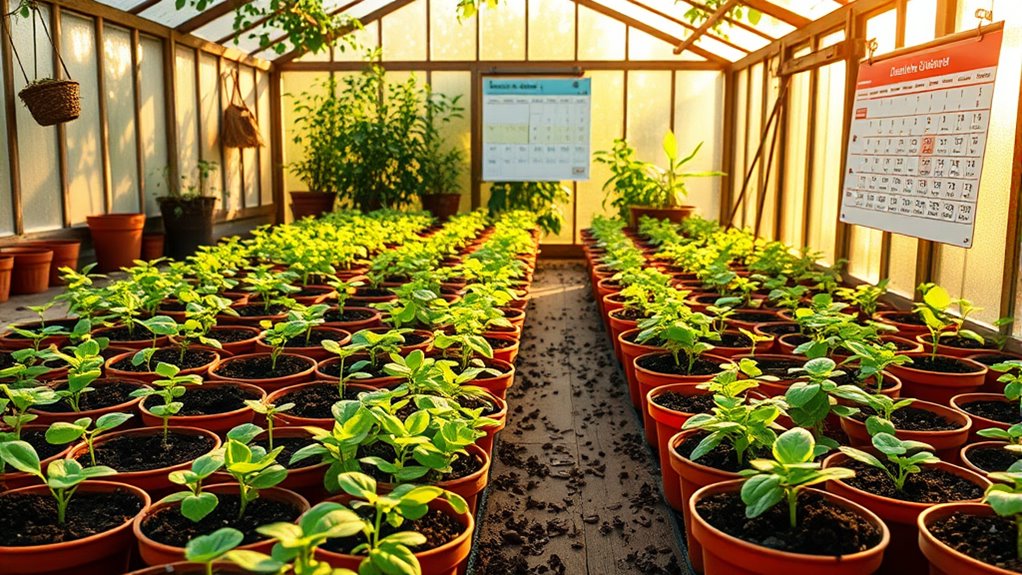
When planning your outdoor planting, it’s crucial to consider the timing of your seedlings’ growth in relation to local climate conditions.
Start by determining your area’s last frost date; this will guide when to move your plants outdoors. For cold-tolerant crops like lettuce and peas, you can plant them in early spring. Warm-season plants, such as tomatoes and peppers, should wait until after the last frost.
Be sure to harden off your seedlings by gradually acclimating them to outdoor temperatures. Monitor weather forecasts to protect against unexpected frosts, and remember to prepare your soil beforehand.
Frequently Asked Questions
What Tools Are Essential for Greenhouse Setup?
For a successful greenhouse setup, you’ll need several essential tools.
A scoop helps transfer potting soil, while a dibber is perfect for making holes for seedlings.
Keep a weeding tool handy for removing unwanted plants, and use a tamper to compact soil in trays.
Don’t forget a window cleaning tool to maintain visibility.
With these tools, you’ll create an ideal environment for your plants to thrive and flourish.
How Do I Choose the Right Greenhouse Size?
Imagine your dream greenhouse, a sanctuary for your plants.
To pick the right size, start by measuring your available space, allowing room for paths and future expansion.
Think about the types of plants you’ll grow; leafy greens need less space than tomatoes.
Ensure your greenhouse has enough sunlight and ventilation.
Lastly, consider your budget—smaller setups are less costly, but larger ones offer more growing potential.
Choose wisely, and your garden will thrive!
What Are the Costs Associated With Greenhouse Maintenance?
When you think about greenhouse maintenance costs, you’ll typically encounter expenses for annual upkeep and repairs.
You might spend between $50 to $200 for maintenance, depending on your greenhouse’s condition.
If repairs are needed, the average cost is around $1,460, but it can vary widely.
Factor in labor costs, which range from $40 to $100 per hour, especially if you’re hiring professionals.
Simple DIY repairs can save you money and keep your greenhouse in top shape.
How Can I Improve Greenhouse Airflow Naturally?
Imagine your greenhouse as a sailboat, catching the gentle breeze of nature.
To improve airflow, position your greenhouse to harness the wind, placing vents strategically for optimal flow. Install roof vents to let hot air escape and consider opening roofs or roll-up sides that welcome the fresh air.
Keep windows and doors ajar, allowing the natural currents to dance through, ensuring your plants thrive in a refreshing atmosphere.
What Are Common Greenhouse Design Mistakes to Avoid?
When designing your greenhouse, avoid common mistakes that can hinder growth. Make sure it’s in a sunny spot, ideally receiving at least 6 hours of direct sunlight.
Pay attention to orientation to ensure even heating. Use durable materials for the structure and maintain proper ventilation to manage humidity.
Don’t rush the planning phase; a well-thought-out layout can maximize space and productivity.
Regular maintenance is key to keeping your greenhouse healthy and efficient.
Conclusion
As you prepare your greenhouse for the spring, remember that a well-organized space can boost your yields by up to 25%. By deep cleaning, efficiently arranging your tools, and implementing effective pest management strategies, you’ll set yourself up for a thriving growing season. Don’t forget to monitor your watering practices and environmental controls. With these steps, you’ll not only grow healthier plants but also enjoy a more productive gardening experience. Happy planting!

